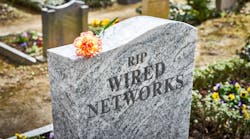Does the relentless expansion of wireless technologies and services signal the end of wired networks? Does the growth of the Internet of Things, forthcoming 5G, and ever-faster Wi-Fi foretell the eventual death of copper cabling? Some are predicting just this. Here are my thoughts.
The Wired World
How many times have we wired the world? The first wired network was the telegraph, circa 1850. I’m not making this up. Telegraph lines actually came before the telephone and electrical power transmission. These didn’t show up until the late 1870s through the early 1900s. All three—telegraph, telephone and electrical power businesses—eventually created massive networks and grids that remain today. The telephone system grew into a massive enterprise including fiber and DSL wiring.
But that’s not all. In the 1960s, we got community TV antenna systems that morphed into the huge cable TV networks. Today these hybrid-fiber-cable (HFC) systems cover most of the U.S. In the 1970s and later, local-area networks (LANs) began connecting millions of PCs with twisted pair.
Somewhere along the way, factories, process plants, and other industrial facilities got wired with fieldbuses like HART, Modbus, PROFINET, Ethernet, and others. Office buildings, homes and even complete cities were wired with twisted-pair Ethernet. And let’s certainly not forget the Internet and all the related fiber connecting the world. Now, wired networks have taken hold in cars, SUVs, and trucks. New vehicles have LIN, CAN, MOST, even Ethernet. What have I left out?
Given the huge wired infrastructure, you would think that the answer to the burning question is a solid “NO, wireless is not killing the wired world.”
Wireless is Winning
However, all of the most recent networking hype, development, and application seems to be wireless-related. Wi-Fi everywhere. Massive expansion of the 5G cellular network and billions of smartphones. The public switched telephone network is fading away as subscribers abandon it for cellular service only. Bluetooth cable replacement, wireless headsets and speakers, and many others. Satellite TV distribution competing with cable TV.
Then there’s the Internet of Things that’s mostly wireless with its billions of sensors. Wireless utility-meter reading. And no telling how 5G will affect things. Initially, 5G broadband wireless services will challenge the DSL operators and cable companies.
With all those wireless signals floating around, it’s amazing that the EMI hasn’t compromised at least some of those systems. It’s only going to get worse, so we should all be worried.
The Death of Wired Systems is Premature
Mark Twain is acclaimed to have said “The reports of my death are greatly exaggerated.” That’s probably the case here. When you think about it, aren’t many if not most of those wireless systems tied together to other networks with cables?
The cellular system can’t exist without all of those attendant fiber interconnects. Server interconnects in data centers use exotic cabling like Infiniband. And isn’t it wired Ethernet that ties all those Wi-Fi access points together to a server in a closet that is connected to outside fiber. Home wireless still needs that cable or DSL wiring to get internet access. Don’t all wireless networks actually have a wired connection to some other system?
Clearly, we have taken our reliable wired networks for granted. They’re considered old technology and get no recognition or appreciation. However, despite this inattention, even disrespect, wired networks continue to improve. The cable TV HFC systems keep gaining more speed thanks to the latest upgrade to the DOCSIS standard. It can easily handle 1-Gb/s data, and even faster in some instances.
DSL has also ramped up its speed over the years as companies invented technologies that let you put 1 Gb/s of data on a twisted pair. And, after all these years, the telecom companies discovered how to minimize 60-Hz induced voltage and current interference to the PSTN wiring and DSLAMs by using the mysterious Induction Neutralizing Transformer (INT). The INT has been around for a while, but its effectiveness hasn’t been fully exploited. Fast data can be achieved over twisted pair by using the latest standards such as VDSL2, G.fast, and others thanks to the INT.
As for other examples of a healthy wired infrastructure, consider these. Many of the small cells needed for 5G will be fiber. IoT nodes are aggregated in gateways wired to some other wired LAN or internet connection. DSL and cable internet connections to homes and businesses aren’t going away. New 5G broadband wireless may take some business, but not all.
If you want an in-depth look at this issue, get a copy of the new book Computer Networking Breakthroughs You’ve Always Wanted, without needing fiber optic cable…even in the age of the Internet of Things. It’s written by an acquaintance of mine, Russ Gundrum, a veteran of the telecommunications and cable businesses. He’s also the guy to thank for promoting and deploying the INT.
My conclusion is that wired networks still serve a real purpose. We actually can’t get along without them. Yes, wireless is getting all of the attention right now, but we should pay some respect to the wired networks we use every day.

